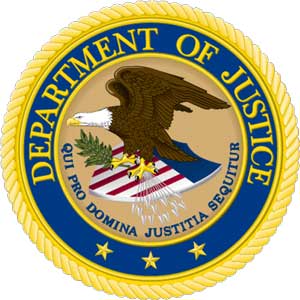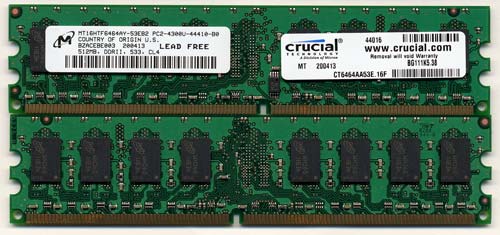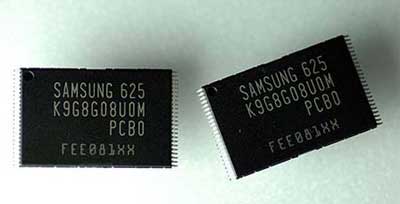
Original Link: https://www.anandtech.com/show/2355
In Memory Of The Law: The Memory Industry's Legal Problems
by Ryan Smith on October 25, 2007 3:00 AM EST- Posted in
- Memory
In 1890 the United States government passed the Sherman Antitrust Act, a law that formed the bedrock of the United States' policy against monopolies and other unfair forms of competition. In the many years since then, further acts have been passed to amend the law, and the Government has in time made the correction of anti-competitive actions one of its more important roles. What started with the breaking up of truly gigantic corporations like Standard Oil and AT&T has moved on to include dealing with cartels that while not of a single corporation, act at times in manners similar that result in anti-competitive actions taking place.
If we were to take a cursory glance at the computing industry as a whole and try to pinpoint the areas where anti-competitive legal issues were likely to occur, we'd look at areas like CPUs and GPUs, where only a couple of serious competitors exist in each, or operating systems, where Microsoft has and continues to have a de facto monopoly. While these areas do in fact have issues, we would be missing an area that has shown some of the worst behavior. It turns out that the memory industry is one of the greatest offenders.
Generally speaking, it's counter-intuitive to see the memory industry as being a hotbed of legal woes due to the highly competitive nature of the market. With the JEDEC association setting very rigorous standards for RAM, products are quite literally perfectly competitive (from a non-overclocker's point of view): a part specified to meet a certain JEDEC RAM standard should be just as good as any other part that adheres to the same specification. As a result, OEMs can and do switch RAM on a regular basis depending on who can supply it at the lowest cost, and as a result we usually see the memory market operate as it is: a highly competitive market in which multiple companies supply the same good.
But didn't we just say that the memory market is one of the greatest antitrust offenders? Yes, for in spite of the memory market being very cutthroat, it's also an industry that is subject to highly volatile demand. It can be extremely profitable as a result when demand is far outstripping supply and it takes years to bring new fabs online to produce additional memory. It's the profitability of these periods that keeps nearly a dozen major companies in the business. With such volatility however, it also opens the window for manipulation of this volatility - if now is not a boom year, why not make it one?
Over just the last decade, the memory industry has been through no less than three major shakeups. The first is the infamous and now settled Rambus patent case, started in 2000 when Rambus asserted that it held patents on technology used in DDR RAM and wanted royalties as such, only to be found guilty of breaking antitrust and deception laws in acquiring these patents and covertly trying to influence the memory market. The second case involves the "Big 10" memory manufacturers colluding to keep RAM prices artificially high between 1998 and 2002, to which they were found guilty. Finally, a new investigation has opened up as of this year into the flash memory market, where the Justice Department is trying to figure out if there is evidence of collusion and price-fixing there too.
Today we'll be taking a look at the latter two actions, one just wrapping up while another begins. What exactly went on in these cases? How are or potentially were consumers hurt by all of this? What has been done to punish the offenders and to correct the market? Let's find out.
DRAM Price Fixing
In 2002, the major American computer OEMs banded together to complain to the United States Justice Department about potential anti-competitive actions in the memory market. From 1999 up to that point, the OEMs had been paying fairly high prices for their RAM for a sustained period of time, which was unusual given the volatile nature of the market. Given in particular the economic slowdowns in that period of time, the demand for RAM surely should have been well below the supply, and prices should have been hitting rock-bottom as a result. While the market was fluctuating somewhat, prices had not come down like they should have.

Starting with the complaints from the OEMs, it only took the Justice Department a year to start finding memory manufacturers guilty of engaging in price fixing as the OEMs believed. All told, the list of companies found guilty was practically a who's who list in the memory world, where no less than nine companies eventually pled guilty and/or settled. The companies were:
- Infineon
- Samsung
- Hynix
- Elpida
- NEC
- Winbond
- Micron
- Mosel.
- Nanya
In the 3-year period of anti-competitive behavior, the memory cartel is estimated to have overcharged American OEMs by at least a billion dollars, which in turn was eventually passed on to consumers. The direct consumer cost - that is consumers who were directly overcharged as opposed to being overcharged through their OEMs - is unknown, but given the shape of the market this would only be a fraction of the cost through the OEMs.
As for why this happened, there are two reasons given. The first is fairly typical: a desire to make more money. By fixing prices the cartel pulled in an additional billion dollars in the American market alone and avoided some of the drag from the economic slowdown of the period. A second reason that has been proposed has been that the price-fixing was done to force Rambus' RDRAM out of the market at a time when they were beginning their patent suits. RDRAM was subject to price fixing like all other forms of DRAM, and ended up always being priced comparatively higher than other forms of DRAM. This theory has never been confirmed (simply put, the Justice Department's job doesn't include finding out why the cartel did what it did), but it has always seemed extremely likely given the timing and the fact that RDRAM did indeed die in part due to high prices.
The real meat of the issue is not the cartel engaging in price-fixing; it's the punishments for doing so. The total of all the fines and settlements is well over a billion dollars, and with the addition of other associated costs the penalties are believed to be well in excess of the ill-gotten profits from the whole operation. Samsung, believed to be the ringleader of the cartel, holds in particular the dubious distinction of having paid the second largest antitrust fine ever to the Justice Department, at $300 million (and this doesn't include any further settlement costs). Hynix took the number three spot at $185 million, and Infineon became number four at $160 million.
Along with monetary fines, executives from several of the guilty cartel members were also directly found guilty and forced to pay their own fines and serve jail time. Individual fines ranged between $100,000 and $250,000, with jail sentences between 4 and 8 months.
Finally, on top of any official fines for their actions, there are the class action suits brought against the cartel to recover some of the money that the cartel overcharged. The members of the cartel have settled the class action suits to a total of $326 million, to settle any wrongdoing they've done towards anyone who purchased memory directly from the cartel. Now since this is only for direct purchases, the majority of the parties are the OEMs and mid-level companies that assemble and sell DIMMs; however, an interesting side-effect of this settlement is that end-users are also part of the eligible party when they purchased memory directly. Micron directly owns and operates the Crucial brand, so end-users who purchased memory from them in the time period are in a unique position of being one of the few (if not only) groups of users that will see a dime out of this settlement.

All told, the numbers from the operations of the memory cartel are staggering. Nine core companies with a number of subsidiaries of their own managed to organize themselves long enough to overcharge buyers by a billion dollars over a three year period. This is obviously illegal but at the same time it's an admittedly impressive act of collusion. In return they have been fined and sued for well over a billion dollars, easily erasing any gains and filling the better part of the United States Justice Department's top 10 fines list.
And yet the end isn't quite here. They say the wheels of justice turn slowly; one only needs to look at the time frame of this case to see why. What started as collusion in 1999 became an investigation in 2002, and claims for the class action suit will continue to roll in until the very end of 2007. By the time the claims are paid and the book is finally closed on this case, it will be 2008, some nine years after the initial crime started and six years after the investigation started. Retribution has been a long time coming. Sadly, while OEMs were indeed overcharged during this period, the reality is that it's the end customers that were really forced to foot the bill. Score points for the OEMs, the DOJ, and the lawyers; just pay no heed to the average Joe or the businesses that were overcharged for PCs or RAM during this period.
A New Investigation and Closing Thoughts
With the total damages levied against the various memory manufacturers in the DRAM case, we would hope and expect that it would discourage any such future foul play - certainly that's much of the reason for the fines in the first place. However, hot on the heels of the DRAM investigation (and a more minor ongoing SRAM investigation) the Justice Department believes it has found new examples of anti-competitive behavior. Many of the players are the same but it's a different market: NAND flash memory.
NAND flash memory (not to be confused with the NOR type) has been a particularly hot industry over the last few years as the capacity for NAND has been growing at a faster rate than any other type of storage, allowing device manufacturers to use NAND on products that previously required other forms of mass storage. Cell phones, MP3 players, PDAs, and even SSD hard drives have made for rapid growth in the NAND flash memory market. Markets ripe for growth however can also be ripe for anti-competitive actions, which is why the Justice Department is taking a look.
Because this investigation is just beginning, the details are relatively sparse compared to what we know about the DRAM case. Many of the companies involved in the DRAM case also make NAND flash memory, and the Justice Department believes they may have been acting in anti-competitive ways similar to what occurred in the DRAM case. The Justice Department has now subpoenaed many of the manufacturers and purchasers of NAND flash memory in order to start building a case; so far everyone subpoenaed has cooperated with the investigation.

Prior to the start of their investigation, the price of NAND had been increasing the past couple of quarters (between 5% and 10% a quarter). Some business analysts and members of the Justice Department find this unusual enough to indicate that something may be amiss. Furthermore, in a separate case that started a month prior to the Justice Department's case, a group of NAND purchasers sued nearly two dozen companies involved in NAND production, accusing them of engaging in price-fixing. Finally, there is concern that the corruption uncovered in the DRAM cartel may have spread into other memory markets.
With that said, at this point it's far too early to make any serious accusations on what is being investigated. The Justice Department started a similar probe of SRAM in 2006 which so far has not turned up anything notable, so it's entirely possible that this is the Justice Department being overly paranoid and there is nothing to find. We have heard rational explanations that would account for the price increases without illegal practices such as price fixing. On the other hand, this is a market that from past experience is clearly vulnerable to collusion, so it's too soon to dismiss any claims about collusion or price fixing until more investigating is done and we have more facts. One thing is certain: if there is something foul going on, you can count on it taking most of the next decade before everything is sorted out.
Closing Thoughts
The fact that we are writing this article is in and of itself an indication of our disappointment with the memory market. Although it's not the end-users that will be seeing the restitution from the DRAM case, it was ultimately the end-users who paid the extra cost. In colluding to raise prices, the DRAM cartel has effectively ripped off virtually every one of us. Even though "justice" has been done, few of those who were truly wronged will be getting restitution for what has happened.
There's a fundamental belief in the market that if prices are high, there is a good reason for it. Perhaps something costs a lot to make, there's little supply, or someone along the way was smart enough to build a better product and command a premium for what they can offer. However, even in the cold hard world of capitalism there's a certain breach of trust when the participants in the market are colluding to rip the consumer off, and that has happened at least once.
This article is admittedly late. What's done is done and other than the class action suit the rest of the punishment has been served and most everyone has moved on. At the same time, the computing industry in spite of its size has a very small feeling much of the time; this is what drives things such as brand loyalty and fanboyism for companies and products. It's an unusual but functional relationship that keeps things going, but situations like this sour that relationship. The computing industry already has its villains; do we really need more of them?
At this point we're waiting for the result of the Justice Department's investigation into the possibility of similar price fixing for NAND flash memory; we hope these accusations aren't true, but it's far too early to know the truth. For this kind of problem to occur once, it's a disappointment but redemption is a possibility. For it to occur again may very well mean constant suspicion of bad behavior and overcharging will be the new modus operandi for the memory buyer. We would much rather have heroes to praise than villains to fear and avoid.







